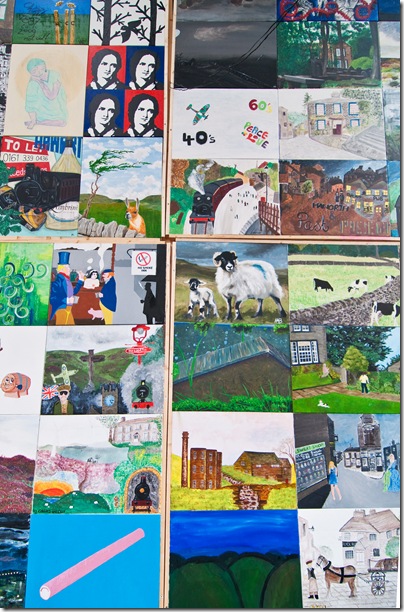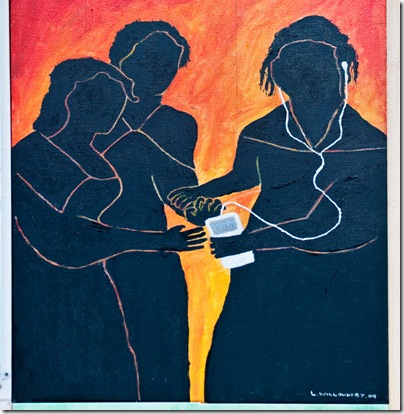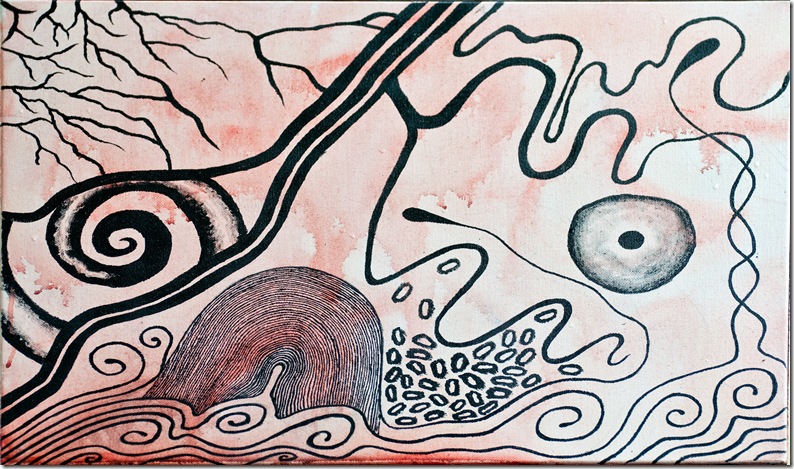
Visiting Howarth on the same weekend as the classic car rally at Hebden Bridge, I chanced upon their annual ‘Wall of Art’ Project and was really impressed with the creativity on display outside the Black Bull Inn. As the printed description says, this is something for the whole village, a single project which unites them around a common task.
The interpretations of the theme ‘Howarth, past and present’ are about as varied as could be. Each painting is a unique expression of how that person’s creative imagination engaged with the theme, and there is much humour, tangential thinking and deeply perceptive seeing in evidence. This display was a heart-warming and most unexpected gift in the middle of a rainy day. I particularly liked the painting of the Bronte Sisters with a white iPod, especially having a few minutes earlier seen a reproduction of the original group portrait hanging in the Bronte Parsonage Museum. The abstract take on Haworth from a geological and evolutionary perspective on the past was equally striking.
What all of this art did was to lift my spirits: being in the presence of such communal creativity seemed to intimate something especially precious about our humanity. At the time I was reading Pete Ward’s latest book ‘Participation and  Mediation’. His view of contemporary youth culture is that we can legitimately see ‘symbolic creativity’ as a holy activity of meaning-making. In this light the ‘Wall of Art’ is indeed about the making of meaning around a common theme, and as such I want to argue that the huge display is inherently sacred.
Mediation’. His view of contemporary youth culture is that we can legitimately see ‘symbolic creativity’ as a holy activity of meaning-making. In this light the ‘Wall of Art’ is indeed about the making of meaning around a common theme, and as such I want to argue that the huge display is inherently sacred.
If as the Bible contends we believe that God is creative, and that divine creativity is always and everywhere at work through the presence of the Holy Spirit, our imaginations have real sacred significance. Imagination is the starting point for meaning-making and the creative shaping of our lives for the good. As such, as individuals in community with one another, we are all unfolding and unfinished works of art, each of which expresses something of divine meaning-making in action. Following this line of thought leads me to think that if we are open to the divine imagination and loving intention which God has for us, we will find our imaginations suffused and inspired with holy creativity. Surely it is the most natural thing in the world for God to engage with our inherent creativity in this way? When the two come together the result should reflect the meaning-making we see in Jesus. The previous post tried to mirror this truth through attention to the creative process of seeing reflectively.
As the residents of Howarth celebrate their collective creativity is it possible for us to see that this has a holy dimension? Can we read the Christian belief that we are ‘made in the image of God’ in a way that allows us to assert that the magnificent creativity of the ‘Wall of Art’ discloses to us an essential characteristic of both divine and human identity?
 I think we can. These paintings are not religious in the accepted sense of the word, but I am minded to think that what I saw on the huge display boards is truly iconic in the sacred sense.
I think we can. These paintings are not religious in the accepted sense of the word, but I am minded to think that what I saw on the huge display boards is truly iconic in the sacred sense.
In paint, line, shape and colour there lurks a sacramental truth about the past and present nature of our relationship with God, and God’s creative loving relationship with the whole of life. Here in Howarth this cultural expression of identity is an exercise in meaning-making for the whole community. The wall of the Black Bull Inn becomes the place where theology and culture meet.
The theological task and challenge would be to unpack this in ways that ‘make spiritual meaning’ for the residents of Howarth.
Where, how and why might the meaning of God be discovered through the ‘Wall of Art’?









No comments:
Post a Comment